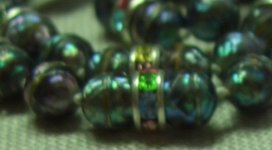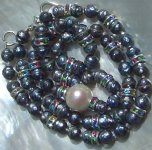Another query we received concerned faceted pearls. It seems a dealer had a quantity of blemished Tahitian SSPs on hand that were difficult to sell, and he wanted to look into having them faceted. We had run an article on this process some time ago concerning two elderly gentlemen in Kobe, Japan, who laboriously hand faceted pearls with ancient, wooden tools and techniques. As we looked into this further, we found a recent Colored Stone article about a firm in Tokyo that also specializes in faceting pearls:
"Komatsu Diamond" read the sign above the booth at International Jewellery Tokyo, where I first met father and son Kazuo and Kazuhito Komatsu. But it was their pearls, not their diamonds, that caught my eye.
Komatsu started as a diamond–cutting factory in 1967, but– who says the Japanese don’t innovate? - in the early 1980s, company president Kazuo developed a technique that’s changed the way people think about pearls: pearl faceting.
Inspiration for the faceting came when a customer asked Komatsu if he could help him find a way to add value to blemished pearls that were otherwise difficult to sell. Experimentation followed. "But the marks from the blemishes remain, no matter how much you cut away. And bad color remains," explains son Kazuhito. "If faceted, one of these pearls might sparkle, but it still won’t have any luster."
In the ‘80s, round freshwater pearls were still scarce, and South Sea pearls were very expensive in Japan, so initially the company experimented with its techniques on akoyas, the only pearls then available in quantity in Japan. The most difficult part was figuring out how to polish the ultra-thin, soft nacre, and it remains their biggest challenge today.
"Every day we’ve tried new things, and little by little we’ve realized, ‘If we do this, it shines a little more, and if we do that, it will shine a little more,’" describes Kazuhito. "We didn’t have any books on the subject, and there wasn’t anyone to teach us how to do it, so there was nothing for us to do but try everything we could think of. If we got as pearl facet to shine a little, we thought we’d made a bit of progress."
It was 1992 before they completed their first samples, and they unveiled them that year at Internationally Jewellery Tokyo.
The technique for faceting pearls, for which Kazuo holds a patent, is based on his experience with diamond cutting and polishing, adjusted to cope with the softness of pearl nacre. "The technique is based on diamond cutting and polishing; they are fundamentally the same," he says. Part of Kazuo’s research included adapting tools for pearl cutting and creating new ones to polish the pearls.
"Polishing the pearls is terribly difficult. In general, the cutting is definitely more difficult than for stones," recalls Kazuhito. A total of four cutters in the com¬pany are qualified to do the pearl faceting. All started out first cutting diamonds and other gemstones, then moved to pearls.
"The end product has a mysterious shine to it," says Kazuo. "Even after thinking everything through and researching it for years, I was surprised that they came out so beautifully.
"Just like the facet of a cut stone, the face of a pearl facet shines," says Kazuhito. "The difference is that the nacre of the pearl consists of layers, and each of these layers has a natural luster that shines as well."
The special feature brings with it a fundamental challenge, however. "If you make a mistake cutting a stone, it is still stone down to the core, and you can, theoretically, ‘fix’ your mistake," he explains. "But if you accidentally cut down to the nucleus at the core of a pearl, then the pearl has no value."
Though the company can facet almost any kind of pearl, Kazuhito emphasizes that they cannot change a pearl’s shape.
Baroque pearls’ irregular forms make them difficult to cut with a symmetrical pattern, and thus the company works almost exclusively with round or drop-shaped pearls. Because the cutter calculates the angles before working, round pearls are somewhat easier to work with. Each drop pearl is different, so each one’s angles must be separately calculated.
The company can do "mirror ball" cuts (with square facets), but their favored facet patterns look like flowers from above, made with either triangular or diamond-shaped facets.
Experience has shown that working on fine-quality pearls yields the best product and the best customer satisfaction. As a result, even before cutting, these pearls are not inexpensive. However, since the company buys loose pearls and strands in bulk, it can keep costs down, to the extent that their pearls are not much more expensive than unfaceted pearls of similar quality, adds Kazuhito.
Most of the pearls the company works with are from the South Seas, particularly Tahitian black pearls, which currently represent about 70 percent of production. The larger sizes are easier to work with and show off the technique; moreover, Tahitian pearls are relatively inexpensive, and the end product sells well.
"But akoyas have the best luster, even now. It’s also the most delicate, because the layers are so thin," Kazuhito points out. Before cutting an akoya pearl, the cutter looks inside the drill hole to see whether or not there is enough nacre thickness to facet the pearl; if not, the cutter chooses another. There’s no standard measurement for thickness, though: Cutters learn through experience to tell whether there’s enough nacre for faceting or not.
Currently, the Komatsu factory produces about 1,000 faceted pearls a month, of varying sizes. There are no plans to increase production, primarily because of the time and investment required for training.
The company chooses pearls to facet together with its clientele; some customers provide their own pearls, while the company can supply pearls for others based on size, color, budget, and selling price. Over time, ongoing clients learn what kinds of pearls look best with facets and which ones sell well.
Most of Komatsu’s customers for faceted pearls are wholesalers, though there are jewelry designers as well, including some Italian brand-name designers and someone Kazuhito terms "a well-known designer in the U.S." Outside of Japan, the United States, and Italy, the company also sells its faceted pearls to clients in Taiwan and Bangkok, Thailand. Most customers are firms that do not specialize in pearls, suggesting that this innovative technique has opened up some new markets for pearls.
Overseas customers tend to like faceted Chinese freshwater pearls.
The Komatsu company cuts these in sizes from 5 mm for pierced earrings to 9 mm and 10 mm for necklaces and 11 mm for rings and pendants.
In Japan, freshwaters have a strong image of being "cheap pearls," Kazuhito says, making them more difficult to sell to the domestic market. But they’re still useful for niche jewelry that is difficult to create with akoya and South Sea pearls. For example, a necklace made entirely of 10-mm pearls would be difficult to obtain and prohibitively expensive if made with akoya or South Sea pearls. When done in freshwaters, it sells because of its uniqueness.
Though Kazuo was the first to facet pearls, the popularity of this new look has spurred other companies to experiment with the technique. There are Chinese and Australian manufacturers who also facet pearls, but the Komatsus aren’t worried about the competition.
"Their thinking is totally different from ours, as are the quality of their materials and their cutting," says Kazuhito. "It’s a completely different product."


